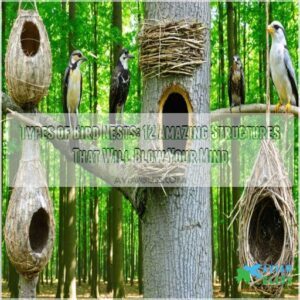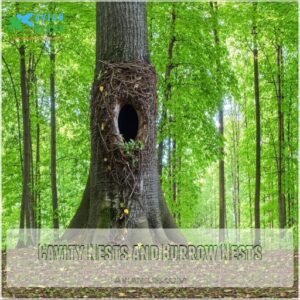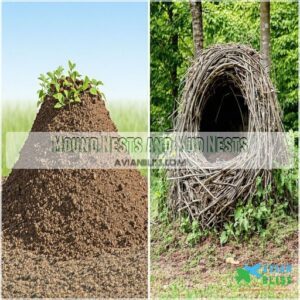This site is supported by our readers. We may earn a commission, at no cost to you, if you purchase through links.
 Birds craft an incredible variety of nests, showcasing their resourcefulness and adaptation to their environments. Each type is designed with purpose, proving nature’s architects never fail to impress.
Birds craft an incredible variety of nests, showcasing their resourcefulness and adaptation to their environments. Each type is designed with purpose, proving nature’s architects never fail to impress.
You’ll find cup nests, like those of robins, built with grass and mud; platform nests, flat and sturdy, often used by eagles; and cozy cavity nests hidden in tree trunks or walls, perfect for woodpeckers.
Ground nests, favored by plovers, blend seamlessly into the dirt, while hanging nests, like the weaverbird’s, swing elegantly from branches. Some birds even get creative—owls burrow underground, and bank swallows tunnel into cliffs.
Ready to explore more wonders?
Table Of Contents
Key Takeaways
- You’ll discover that birds build nests in a variety of styles, like cup nests, platform nests, and hanging nests, each serving specific survival needs.
- Birds use diverse materials like twigs, mud, spider silk, and even urban debris, showcasing their adaptability and resourcefulness.
- Nesting locations range from tree canopies and cliffs to underground burrows and floating water nests, depending on the species and environment.
- Birds’ nests reflect incredible engineering, from protective camouflage and temperature regulation to communal designs for safety and cooperation.
Characteristics of Bird Nests
You’ll discover that bird nests range from simple grass cups to elaborate woven structures.
Using materials like twigs, mud, and even spider webs to create their perfect homes.
Whether built high in trees or tucked away in burrows, these remarkable structures protect eggs and chicks.
While showcasing the incredible engineering skills of our feathered architects.
Materials Used to Build Nests
You’ll find birds are nature’s master builders, carefully selecting nesting materials from their surroundings.
They’re experts at nest weaving techniques, gathering everything from plant fibers and twigs to mud and spider webs.
Many species rely on specific Bird Nesting Materials to construct their nests, which can vary greatly depending on the type of bird.
Some species create sturdy structures by mixing mud with precise ratios of grass, while others delicately weave flexible nests using soft materials.
Even human-made items like string and cloth sometimes make their way into these architectural masterpieces.
Size and Shape Variations
Bird nest structures vary dramatically in both size and shape, from the tiny penny-sized hummingbird nests to massive eagle platforms that can weigh over 2 tons.
You’ll find incredible shape adaptations across species – from the Baltimore Oriole’s hanging pendulum to the Red-winged Blackbird‘s deep cup design.
Nest architecture reflects each bird’s unique needs, with structural reinforcement varying based on location and materials available, showcasing incredible shape adaptations and massive eagle platforms.
Entrance Hole and Temperature Regulation
The entrance hole isn’t just a doorway – it’s a masterpiece of nest architecture that helps birds control their home’s climate.
You’ll find cavity nests with perfectly sized openings that keep predators out while maintaining ideal temperatures inside.
Different bird species adaptations show in how they craft these entrances, using insulation materials like moss and feathers to regulate warmth across various nesting climate zones.
Nesting Locations and Habitats
While entrance holes serve as gateways to safety, bird nesting sites are scattered across diverse landscapes. Here’s where these feathered architects set up home:
- Urban nesting sites transform skyscrapers and bridges into vertical sanctuaries.
- Tree canopy habitats offer natural protection in towering oaks and maples.
- Coastal cliff dwellings provide isolation from ground predators.
- Cave systems and riverbank erosion create ready-made shelters in unexpected places.
Birds adapt by using natural nesting materials to turn nearly any environment into their perfect nesting grounds. You’d be amazed how these creatures turn nearly any environment into their perfect nesting grounds.
Types of Bird Nests
Birds create nests in ten distinct styles, from simple cup-shaped structures to intricate hanging baskets woven from plant fibers and spider silk.
Each type of nest serves as a carefully engineered home that meets the specific needs of different bird species, providing protection for their eggs and young against weather and predators.
Cup Nests and Their Features
A small masterpiece of avian engineering, cup nests showcase nature’s architectural brilliance. These cozy dwellings are crafted from twigs, grass, and moss, often lined with soft feathers and fur for extra comfort.
Each species brings its unique touch to cup nest construction, from tiny hummingbird homes to larger blackbird abodes. Some birds, like the dusky scrubfowl, construct enormous nest mounds that measure over 11m in diameter and stand nearly 5m tall.
Platform Nests and Their Advantages
Moving beyond the cozy cup design, platform nests showcase nature’s architectural ingenuity. You’ll find these flat, sturdy structures perched on tree forks or human-made supports, offering birds unique advantages against predation defense and environmental exposure.
- Elevated positions provide excellent visibility while monitoring surroundings
- Stable base supports larger families and heavier species like eagles and ospreys
- Simple design allows quick repairs during nesting season
- Natural drainage prevents water accumulation during storms
Many bird species also benefit from using pre-made bird nesting platforms to provide a safe and stable foundation.
Platform nests prioritize nest stability through strategic material selection, though their open design presents visibility challenges from above.
Cavity Nests and Burrow Nests
Unlike platform nests that sit in the open, cavity nests offer birds a cozy hideaway inside trees or structures. Woodpeckers and nuthatches craft their own holes, while bluebirds and chickadees cleverly use existing cavities. Some birds even benefit from the Cavity Nest Builders.
Underground, some birds take a different approach with burrow nests, digging tunnels that provide excellent predator protection and microclimate control.
It’s fascinating how birds have mastered these different nesting styles for survival.
Ground Nests and Hanging Nests
While some birds prefer hidden chambers, others master the art of ground nests and hanging nests.
You’ll find ground-dwelling species creating shallow scrape nests, perfectly camouflaged against soil and vegetation.
Meanwhile, Baltimore orioles showcase impressive nest architecture with their suspended cup nests, dangling like natural pendulums from tree branches. These hanging homes help with predator evasion, swaying gracefully during bird pairing rituals.
Birds also employ various Nest Building Techniques, such as weaving and interlacing, to construct their nests.
Mound Nests and Mud Nests
Mound nests, like those of malleefowl, are nature’s compost piles. These towering creations of sand and plant litter self-regulate incubation temperature, protecting eggs from predators.
Mud nests, built by swallows or phoebes, showcase brilliant construction techniques—solid structures made of mud and saliva.
Both bird nests types highlight smart engineering, blending safety with adaptability in a unique display of survival strategies.
Floating Nests and Colony Nests
Floating nests showcase nature’s buoyancy, crafted on water and anchored by vegetation for stability.
Common examples include Grebes’ floating nests on lakes.
Colony nests, however, are all about teamwork, with birds sharing massive structures for chick rearing and nest defense.
Common examples include:
- Flamingos’ island-like colony nests.
- Sociable weavers’ group-built nests.
- Herons’ tree-top colonies.
Both floating nests and colony nests highlight clever material choices and collaborative building.
Unique Nesting Strategies and Adaptations
You’ll be amazed at how some birds solve nesting challenges with ingenious strategies and designs.
From burrows and cliffside retreats to nests on human structures, these adaptations highlight their resourcefulness and survival skills.
Burrowing Owl’s Deterrent Tactics
Burrowing owls have clever predator deterrent methods, like scattering debris near burrow entrances to confuse threats.
Their burrow architecture guarantees tunnels are narrow yet protective, ideal for safety.
Nest camouflage techniques often include blending natural materials like grass or dirt. These nesting behaviors highlight impressive adaptations that keep bird predators at bay while showcasing the owls’ resourceful nature and impressive adaptations.
Bank Swallow’s Tunnel-Like Burrows
Ever noticed the craftsmanship of bank swallows? Their tunnel-like nests are engineering wonders. These birds carve cavity nests into muddy cliffs, creating burrow entrances that lead into carefully designed nest chambers.
Their tunnel architecture reduces predators, while the structure aids soil erosion control and adds cliffside stability.
Perfectly adapted to bird nesting habitats, underground burrow nests showcase nature’s resilience.
Sociable Weaverbird’s Apartment-Like Nests
Sociable weaverbirds create some of the most remarkable nest architecture in nature.
These massive communal nests, resembling woven apartments, can house over 100 pairs. With chambers designed for roosting or breeding, the structure regulates temperature year-round.
Built around trees or poles, they offer evolutionary benefits of communal living, like shared protection and easier maintenance.
Truly ingenious bird nest designs!
Opportunistic Nesting in Other Birds’ Nests
Some birds skip the construction altogether and hijack homes.
Through nest takeovers or parasitic breeding, they exploit cup nests, cavity nests, or even suspended cup nests from other species.
Cowbirds and cuckoos use this strategy, laying eggs in abandoned nests or communal nests.
This nesting dominance sparks fierce nesting competition, blending clever survival tactics with interspecies nesting adaptability.
Tree and Shrub Nesting
Birds often choose trees and shrubs for their nests based on height, angle, and cover.
Tree swallows favor cavity nests in hardwoods, while cup nests thrive where leaf cover benefits shade.
Shrub density effects matter for privacy and predator deterrence.
Platform nests on sturdy branches highlight branch angle importance, as nesting species adjust to available tree species for safety and success.
Cliffside and Ground Nesting
On rocky outcrop habitats, birds like puffins craft burrow nests into cliffside ledges, while kittiwakes choose narrow cliff face selections for protection against predators.
Ground nests, like scrape nests of shorebirds, blend into the terrain, overcoming coastal nesting challenges.
These structures, shaped by erosion control methods, highlight clever adaptations for survival in harsh environments. Nature’s architecture never disappoints!
Human Structures and Bridge Nesting
It’s fascinating how certain birds adapt to urban nesting.
House Sparrows and Pigeons frequently use human-built nests, like vents or eaves.
Bridges provide ideal nesting sites for species like Barn Swallows, their mud nests clinging to beams.
Some homeowners even install a birdhouse for bridge to encourage this unique nesting behavior.
These creative adaptations reveal the resilience of bird nests types and highlight the structural impact of human interactions on their nesting sites, showcasing the structural impact of human interactions and the unique nesting behavior in urban environments.
Underground and Floating Nesting Locations
Imagine nesting underground, like burrowing owls, whose burrow nests shield against predators. Or picture water-based nests, like grebes’ floating nests anchored to vegetation, gently bobbing with the waves. These strategies balance predation risks with unique habitats.
Birds also carefully select their nesting site selection based on factors such as food availability and proximity.
Nest evolution thrives in diverse nesting locations—from stable underground nests to floating creations—showcasing nature’s ingenuity in adapting to ground nests and aquatic environments.
Importance of Bird Nests and Interesting Facts
You’d be surprised how much bird nests can teach us about the health of our environment and the resourcefulness of their builders.
From record-breaking eagle nests to hummingbird cradles that stretch as chicks grow, these structures are nature’s hidden masterpieces.
Environmental Indicators and Ecosystem Health
Bird nests are like nature’s health monitors, revealing the effects of habitat disruption and pollution. Changes in nest density or nesting materials hint at climate change impacts. Here’s how they act as a window into ecosystems:
- Declining nest density shows habitat loss.
- Pollution affects nesting materials.
- Climate alters bird habitats.
- Urbanization impacts nest sites.
- Contamination harms bird conservation.
Weaverbird’s Showcase Nests and Mate Attraction
Weaverbirds take nesting habits to the next level, using intricate weaving techniques and careful material selection to craft complex bird nests to impress potential mates.
These spectacular displays of nest-building skills highlight their dedication and capability. The more intricate the design, the stronger the mate attraction.
It’s a prime example of how types of bird nests double as art and matchmaking tools.
Record-Breaking Nests and Hummingbird Nests
Ever wondered about the largest nests or the tiniest homes? Bald eagles hold the record, crafting massive nests over 4,400 pounds.
Meanwhile, hummingbird nests are marvels of efficiency, built with spider silk and plant fibers. These tiny hummingbird homes stretch as chicks grow.
- Record-breaking size: 10 feet wide
- Flexible materials: Spider silk
- Nest construction time: Months
- Incredible adaptability
Scrape Nests and Egg Camouflage
Scrape nests are among the simplest types of bird nests, often shallow depressions in dirt or sand. Their brilliance lies in bird camouflage—eggs are speckled to blend perfectly with surroundings, boosting predator avoidance.
Habitat selection is key, ensuring ideal concealment. Birds like nightjars and shorebirds rely on scrape construction and natural nesting materials to hide both their eggs and themselves.
Scrape nests and other minimal nesting materials are also used by birds like killdeer, as seen in beach nesting birds.
Frequently Asked Questions (FAQs)
How do birds protect their nests from predators?
Sometimes survival means strategy. Birds outsmart predators by camouflaging nests, choosing hidden spots, or building high in trees.
Some even use decoys, like droppings or fake nests, to distract potential threats and protect their young.
Do birds reuse their nests after breeding?
Some birds reuse their nests, like bald eagles strengthening them yearly.
Others, like most songbirds, rebuild fresh ones each season.
Reuse often depends on the species, nest’s condition, and predator risks.
What factors influence where birds build nests?
Birds pick nesting spots like you’d choose a home—seeking safety, comfort, and nearby resources.
Factors include predators, climate, food availability, and habitat type.
For example, orioles prefer trees, while shorebirds favor open ground.
How do birds find materials to build nests?
You’ll often see birds scavenging nearby for twigs, grasses, feathers, or even spiderwebs.
They pick materials suited to their nest needs, often adapting to what’s available—like using urban debris in city environments.
Why do some birds abandon their nests?
Ever heard the phrase, "When the going gets tough, the tough move on"?
Birds abandon nests if predators lurk, parasites invade, bad weather strikes, or if eggs or chicks show signs of being unviable.
Conclusion
Just like a painter uses a palette of colors, birds use diverse techniques to craft nests suited to their needs. From cup nests in trees to floating nests on water, these structures highlight incredible adaptability and creativity.
Exploring the types of bird nests reveals how nature connects species to their environments, ensuring survival and continuity.
These nests are more than shelters—they’re masterpieces of design and function, proving that every bird is a true architect of its world.
- https://cheatsheet.ck.page/055d0f35a6
- https://www.ncbi.nlm.nih.gov/pmc/articles/PMC4242575/
- https://www.sciencenews.org/article/bird-mound-building-australia-ecosystem-malleefowl
- https://birdchronicle.com/types-of-birds-nests/
- https://www.birdsandblooms.com/birding/attracting-birds/bird-nesting/8-different-bird-nests-how-spot-them/



















